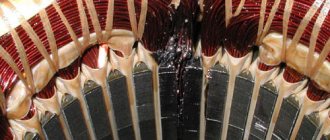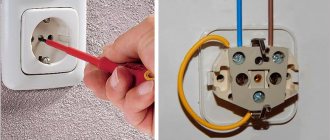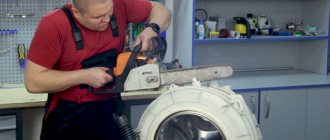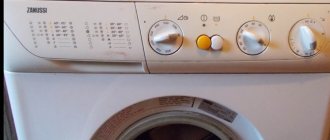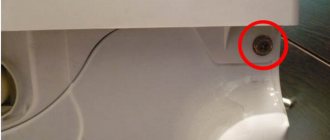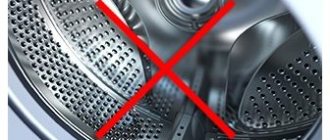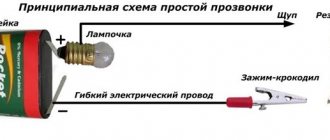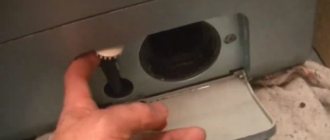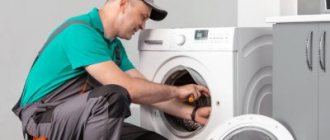Automatic washing includes a set of programmable functions that are displayed on the operating mode control panel. There are no silent washing machines (SMs). Each mode is characterized by a unique set of sounds to which the ear gets used. The introduction of additional sound chords into this scale raises the suspicion that a problem has arisen that needs to be urgently solved.
The washing machine is very noisy
Do not rush to call a technician if the SM does not display an error code; perhaps the reason can be easily eliminated. Try the following:
- control the work of the SM, be nearby;
- determine in which mode the sound appears - drain, wash, spin;
- observe, when it disappears completely, it appears again;
- Record moments when the sound changes volume or characteristic sounds.
This information will help resolve the problem. Even if you fail, the repairman will need it.
Vibration during drum rotation mode
The sound caused by vibration is similar to rattling or knocking; Sometimes the washing machine shifts relative to the initial installation.
Machine inspection
- Check the horizontal installation CM. Adjust the position of the washing machine feet using the adjusting screws.
- Additionally, place shock-absorbing pads or a rug under your feet. This will reduce the noise level and protect neighbors on the lower floor from impact noise. See photo.
- Check the transport screws that protect the CM during transport. Sometimes they remain screwed in after installation.
- Try removing the top cover to check the spring shock absorbers. See photo. There are also shock absorbers at the bottom of the car, LG has 3 of them. and their structure differs from the upper ones. You can check them by removing the front or back panel, but leave this work to a specialist.
- Distribute the drum load evenly to avoid load imbalance.
- Perhaps the fastening of the part has become loose and a sound is being created.
This information will help resolve the problem. Even if you fail, the repairman will need the information.
Noise standards
There is no such term as “buzzing loudly”; it is purely a subjective perception. The level of noise emitted by the machine is determined using special equipment. The maximum values should not exceed the values specified in the documentation; their values directly depend on the type of drive of the washing machine.
Direct drive washing machines can produce noise levels of 52-70 dB. For devices using belt transmission, the permissible values are slightly higher - 60-72 dB.
At home, it is unlikely that it will be possible to accurately measure noise levels, however, the threshold of the permissible value can be heard by ear. If the operation of the washing machine is perceived as background noise without causing discomfort, everything is fine. If the hum and crackling noises come to the fore during washing, drowning out other sounds, you should think about it. It is possible that the machine is faulty.
Causes of extraneous sounds during drum rotation mode and solutions
Sometimes the machine makes sounds when there is no vibration. Determine in what mode of operation the SM produces an unhealthy sound and find out the reason. If the SM makes sounds when the drum rotates, then the reasons are as follows:
- coins, metal objects or haberdashery accessories - buttons, locks, fasteners, other ladies' items that will fall on the walls of the drum and knock while the SM is operating;
- an item squeezed in the space between the drum and the walls of the tank produces sound as a result of friction;
- a whistling sound is produced by a loose V-belt or a peeled part of the belt, remove the protective screen from the rear side of the CM, check the belt tension and condition;
- a sound is possible due to wear of the bearings installed on the drum shaft, check the drum play, try turning it manually, determine whether the drum is braking or engaging the tank walls.
Causes of washing machine noise
If drum braking affects engine operation, the load and standard deviation in the given mode increase. The program will detect a malfunction and issue an error code, but if these values remain normal, the SM will continue to work with noise, but this is a harbinger that there is a problem. It is better to take preventive measures in advance to avoid serious breakdowns.
Causes of noise
Excessive noise during operation of a washing machine can be caused by a number of reasons. In rare cases, this is a careless attitude towards technology, most often it is a sign of imminent failure of the device. Among the main reasons for high noise levels:
- incorrect installation of the machine;
- defective cuff of the loading hatch;
- foreign objects that have fallen inside the washing machine;
- wear of moving parts of the device;
- loose counterweights.
If you can correct mistakes made during installation yourself, then to solve other problems that create noise you will have to partially or completely disassemble the machine. It is up to the owner to do it himself or go to a workshop. In any case, before sounding the alarm, you should make sure that the machine is stable and that there is no excessive vibration during operation.
Extraneous noise during pump operation
According to the instruction manual, regularly check the lint filter installed at the pump inlet of the washing machine. The collected lint will form a bundle and create friction against the pump impeller, causing additional noise. The procedure in this case:
- After completing the operation of the SM, open the lower decorative panel and provide access to draining remaining water from the washing machine tank through the drain hose. Here is a photo.
Here you can see that there was lint in the tank that could cause a problem for the pump.
- Unscrew the filter and clean the sump in front of the pump. Wipe the chamber walls dry, rinse the lint filter with warm water, wipe, check the rubber gasket and put everything back in place.
If the drain is clogged or begins to clog, the load on the pump will increase, which will affect the nature of the noise and the strained operation of the engine. If the changes are within the permissible limits of the program, then the SM will work, otherwise it will turn off and display an error code.
The sound of LG, Indesit, Electrolux washing machines when the pump is running is barely perceptible. The hydraulic part of the transfer pump is made of composite materials and operates durable and silently, so any abnormal sound in the pump operation will indicate a problem related to the mechanical part. pump motors. Therefore, if you have done the work of cleaning the filter, but the noise has not been eliminated, then there may be a problem with the engine.
Extraneous sounds are the first signal that the SM has problems. Diagnosing sounds is a difficult task. One can only speculate about the options. Do not try to solve complex problems yourself, so as not to break the washing machine. This requires experience and knowledge of the SM device. Contact the service center and explain the problem. Learn how to serve and care for your mate.
Worn pulley or drive belt
If a belt-driven device is being considered, another reason why the washing machine is noisy during operation may be wear and tear on the rotation transmission system, namely: a loose pulley or worn out belt. To eliminate the noise in this case, you will have to partially disassemble the machine.
- The back cover is removed, it is held on by several bolts or screws.
- The big wheel just in the middle of the washing machine is the pulley. It must be carefully inspected, checked by hand for the presence of play. If the pulley “goes” there is nothing left to do but replace it.
- The belt is thrown over the pulley. It must be removed and inspected most carefully. In case of severe wear, signs of delamination, cracks, the belt is replaced.
It is also worth paying attention to the condition of the drum shaft. If the pulley has been poorly secured for a long time, wear may form on the shaft.
Noise caused by foreign objects
Often, small parts that get into it along with the laundry get stuck in the washing machine: buttons, coins, fastener parts. Sometimes they pass through the drain system and are caught by the drain filter, but this does not always happen. A small button can get into the space under the drum and get stuck between it and the heating element. In this case, if you spin the drum, you can hear a characteristic noise (creaking and crackling) at the bottom of the washing machine.
To eliminate noise in the washing machine, you need to partially disassemble the device, remove the heating element, tilt the machine, remove objects that have fallen under the drum using tweezers or a bent wire.
Extraneous noise during operation of the washing machine is not just an annoying little thing that irritates, it is a signal to the owner. If you hear a crackling sound or the noise becomes louder than usual, you shouldn’t think too long, you need to find the cause of the noise as quickly as possible and correct it. Doing it yourself or calling specialists is not so important; the main thing is to take action before the problem develops into a serious malfunction.
What to do?
If the reason is forgotten bolts holding the tank, you just need to remove them. Typically these bolts secure the springs on which the tank hangs. They are located on the back wall of the washing machine and can be unscrewed with a wrench without any problems.
If foreign objects get inside the device, be sure to remove them so that they do not damage the mechanism. To do this, the washing machine will also have to be disassembled in order to inspect the tank and remove the obstacle.
If the reason is in the drum pulley, you need to examine its fastening and the integrity of the strap. The fastening may become loose and the drive belt may break as a result of prolonged use of the unit. Instead of a worn-out belt, you should buy a new one, and tighten the loose pulley fastening with available tools.
If the problem is the counterweights, this problem is easy to fix. Counterweights are needed to ensure that the washing machine vibrates less during the spin process. If these structural elements are faulty, the vibrations increase, resulting in a hum. The most common failure that occurs with counterweights is loosening of the fasteners. As in the previous case, loose fasteners simply need to be tightened.
If the rubber cuff is at fault, it would be best to replace it. However, there is a “folk” method for solving this problem. This is done using a piece of sandpaper, which is placed between the sealing collar and the front panel. Then the washing mode starts with an empty drum. After this, you just need to remove the sandpaper and clean the drum from pieces of rubber and sandpaper. It is believed that in this way you can quickly straighten a low-quality cuff.
If you decide to replace the cuff, watch the following video on how to do it correctly.
If the problem is not a breakdown, but an incorrectly connected washing machine, you need to remove all connections and reconnect everything, strictly following the user manual. If you doubt that you will be able to properly connect to the sewer and water pipes, it is better to entrust this work to a professional.
Noise due to problems with the electric motor
The next unit that can cause noise in a washing machine is the electric motor. The most common problem is worn brushes. In this case, the noise is especially loud, in addition to the hum, a characteristic smell is felt, the drum moves jerkily.
The procedure for replacing the brushes itself is not particularly difficult, but one must take into account the fact that you can only get to the motor by completely disassembling the device.
Why the machine makes a lot of noise - common reasons
Let's list the most common causes of hum.
Extraneous sounds during spinning may occur in the following cases:
- before starting to operate the washing machine, they forgot to unscrew the bolts that should secure the tank during transportation of the unit;
- one of the bearings is worn out or damaged;
- a foreign object has entered the cavity between the tank and the drum;
- the drive belt attached to the drum pulley is loose;
- the counterweights installed on both sides of the tank are poorly fixed;
- the rubber cuff has slipped off the edge of the hatch, or it does not fit;
- mistakes were made when installing the washing machine.
This is interesting: Rules for using a washing machine

